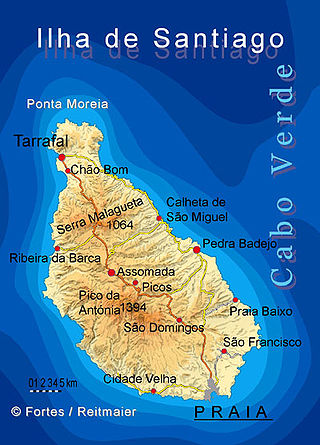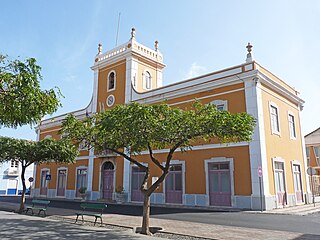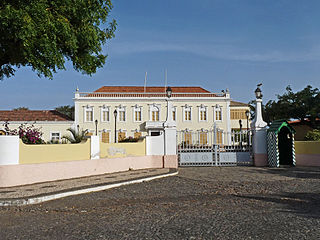| |||||
| Decades: | |||||
|---|---|---|---|---|---|
| See also: | Other events of 2012 Timeline of Cabo Verdean history | ||||
The following lists events that happened during 2012 in Cape Verde .
| |||||
| Decades: | |||||
|---|---|---|---|---|---|
| See also: | Other events of 2012 Timeline of Cabo Verdean history | ||||
The following lists events that happened during 2012 in Cape Verde .
Most transportation in Cape Verde is done by air. There are regular flights between the major islands, with less frequent flights to the other islands. Boat transportation is available, though not widely used nor dependable. In the major cities, public bus transport runs periodically, and taxis are common. In smaller towns, there are mostly hiaces and/or taxis.

The recorded history of Cape Verde begins with the Portuguese invasion and colonization of the island in 1458. Possible early references to Cape Verde date back at least 2,000 years.

São Nicolau is one of the Barlavento (Windward) islands of Cape Verde. It is located between the islands of Santa Luzia and Sal. Its population is 12,424 (2015), with an area of 343 km2 (132 sq mi). The main towns are Ribeira Brava and Tarrafal de São Nicolau.

Santiago is the largest island of Cape Verde, its most important agricultural centre and home to half the nation's population. Part of the Sotavento Islands, it lies between the islands of Maio and Fogo. It was the first of the islands to be settled: the town of Ribeira Grande was founded in 1462. Santiago is home to the nation's capital city of Praia.

Nelson Mandela International Airport, also known as Praia International Airport, is the airport of Santiago Island in Cape Verde. It was opened in October 2005, replacing the old Francisco Mendes International Airport. It is located about 3 km northeast of the city centre of Praia in the southeastern part of the island of Santiago.

Porto Inglês is a city in the southwestern part of the island of Maio in southeastern Cape Verde. It is the main urban settlement of the island, and also seat of the Maio Municipality. Its population was 2,971 in 2010. The name Porto Inglês refers to English ships that exported salt produced on the island of Maio from this town. Salt exploitation continued until the 19th century. The inconclusive Battle of Maio was fought between British and French frigate squadrons close to the town on 23 January 1814 in the last stages of the Napoleonic Wars.

Halcyonair, S.A. was an airline with its head office in Amílcar Cabral International Airport in Espargos, Sal, Cape Verde. It was established in April 2005 and operated domestic flights between the Cape Verde Islands from its main base Amílcar Cabral International Airport.

Cesária Évora Airport is Cape Verde's fourth-busiest airport, located on the island of São Vicente, nearly 5 kilometres (3.1 mi) from the centre of Mindelo. It is located in the valley area in the west of the island and is north of the village of São Pedro. Its runway is 2,000 metres (6,600 ft) long and its width is 45 metres (148 ft)

Praia is a concelho (municipality) of Cape Verde. It is situated in the southern part of the island of Santiago. Its seat is the city Praia, the capital of Cape Verde. Its area is 120.6 km2 (46.6 sq mi), and its population was 131,719 at the 2010 census. The municipality consists of one freguesia, Nossa Senhora da Graça. The city hall is located in the Platô part of the city.

Health in Cape Verde is limited due to limited health care in Cape Verde. Gains since 2000 have led to improvements.

Cape Verde or Cabo Verde, officially the Republic of Cabo Verde, is an archipelago and island country of West Africa in the central Atlantic Ocean, consisting of ten volcanic islands with a combined land area of about 4,033 square kilometres (1,557 sq mi). These islands lie between 600 and 850 kilometres west of Cap-Vert, the westernmost point of continental Africa. The Cape Verde islands form part of the Macaronesia ecoregion, along with the Azores, the Canary Islands, Madeira and the Savage Isles.

The following is a timeline of the city of Praia, capital of Cape Verde.
The following lists events that happened during 2005 in Cape Verde.
The following lists events that happened during 2009 in Cape Verde.
1910s – 1920s – 1930s – 1940s – 1950s – 1960s – 1970s – 1980s – 1990s – 2000s

The Architecture of Cape Verde has different architectural styles in the nation. Unlike the African mainland, Cape Verde was uninhabited until 1461 when the Portuguese arrived, most of the other islands were first inhabited after the end of the 15th century. Its architecture was introduced in the 1460s and has its first origins from Portuguese settlers from the Madeira Islands, after the first arrival of mainland Africans, a bit of African architecture would be elements mainly in rural areas. The Manueline was its first architectural style on the island, it was later followed by Renaissance, Baroque, Pombaline, Early Modern and Modern. It was one of the last in the whole of Africa to introduce architecture late. Cape Verde has one of the richest architecture in the western portion of West Africa, the sub-Saharan portion, the richest probably being Mali.
The Santiago South Zone Cup is the oldest regional cup competition in Cape Verde and is played during the season in the south of island of Santiago, Cape Verde consisting the municipalities of Praia, Ribeira Grande de Santiago and São Domingos. It consists of all the clubs from all the two regional divisions and are divided into about six rounds. The cup competition is organized by the Santiago South Regional Football Association. The cup winner competed in the regional super cup final in the following season. Since 2007, the winner qualifies into the Cape Verdean Cup which were canceled from 2012 to 2017 due to financial and scheduling reasons.
The following lists events that happened during 1960 in Cape Verde.